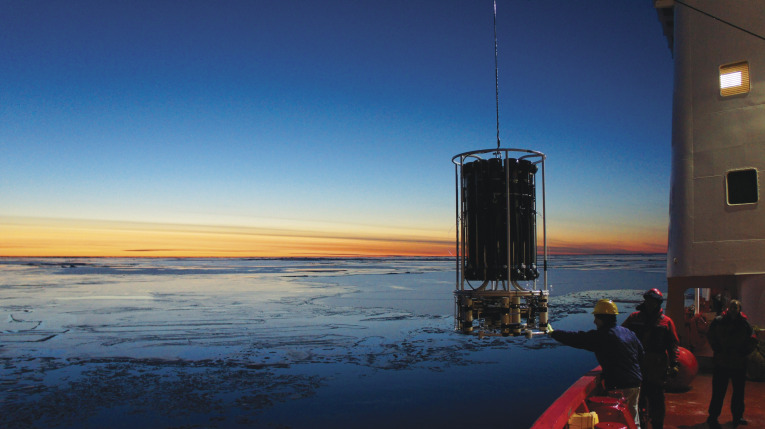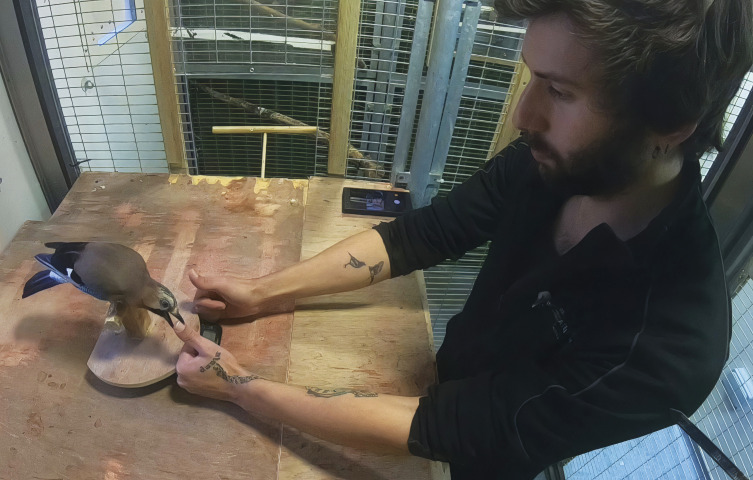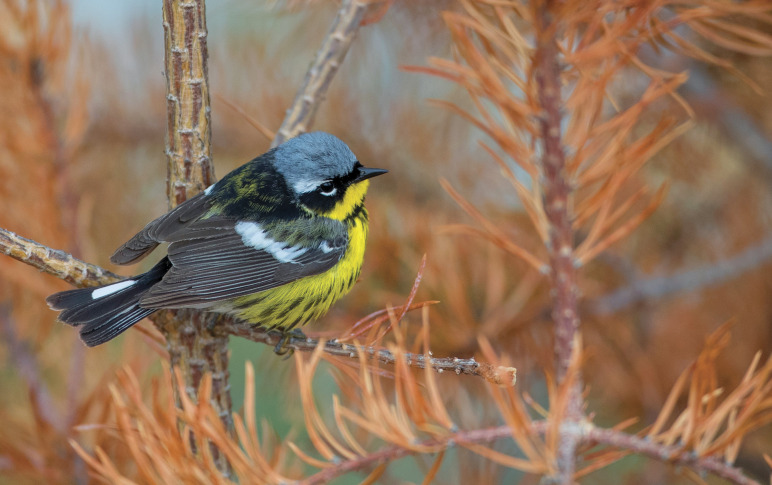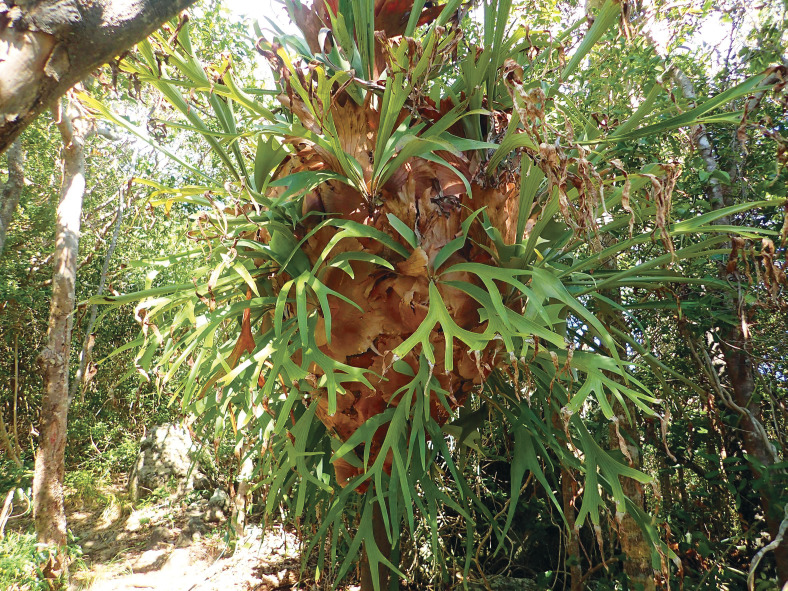EARTH, ATMOSPHERIC, AND PLANETARY SCIENCES
Rosette system for trace metal clean sampling of seawater with Canadian team members during a 2015 Arctic cruise. Image credit: Kathryn Purdon (University of Victoria, Victoria, Canada).
Sources of lead in the western Arctic Ocean
Anthropogenic lead contamination is widespread in the natural environment. However, anthropogenic sources are thought to be negligible contributors to lead in Canadian Arctic seawater. Joan De Vera et al. isolated dissolved lead from seawater samples collected on Canadian Arctic cruises, which were part of an international program to study marine cycling of trace elements, at depths ranging from the surface to 3,500 meters, and measured lead isotopes to determine their provenance. The results revealed that an average of 60% of lead throughout the water column of the Canada Basin came from anthropogenic sources. Based on the isotope analysis, a major source of the anthropogenic lead in seawater was historic lead from Europe and Russia deposited in the Arctic region during the peak of lead emissions in the 20th century. The 20th-century Eurasian lead signature was strongest in the top 1,000 meters over and closest to the continental shelf, suggesting that historic lead pollutants are being remobilized and released into seawater from resuspension of shelf materials and coastal erosion. Thus, the acceleration of melting permafrost and ice and increasing coastal erosion are likely to result in continued remobilization of historic contaminants, and lead isotopes can be a sensitive tracer of contaminants in Arctic seawater, according to the authors. — M.H.
PSYCHOLOGICAL AND COGNITIVE SCIENCES
Eurasian jay making a choice after observing a sleight-of-hand illusion.
How Eurasian jays respond to illusions
To protect food from potential pilferers, large-brained birds, such as corvids, often manipulate food items within their beak in a manner reminiscent of sleight-of-hand techniques used by magicians. Elias Garcia-Pelegrin et al. examined whether sleight-of-hand illusions could deceive Eurasian jays. The authors trained six jays to peck at a fist to retrieve an edible reward hidden inside. During each experimental session, a reward was shown to the jay with one hand and either transferred to the opposite hand or retained in the same hand. If the jay pecked at the fist holding the reward, the jay was allowed to consume the reward. Jays observed three illusionary techniques: palming, which involves concealing an object in the palm; the French drop, which involves mimicking the grab of an object from one hand to the other; and the fast pass, which involves passing an object from one hand to the other quickly enough so that the transfer is unnoticed. Eighty human participants recruited online also observed the illusions via recorded videos. The authors report that jays were significantly less likely than humans to be deceived by French drops and palming, but both groups were equally deceived by fast passes. The findings suggest that humans and Eurasian jays are susceptible to illusions using fast movements, but jays are more influenced by observable motions than expected motions, according to the authors. — M.S.
ENVIRONMENTAL SCIENCES
Social inequality in energy use
Data on social inequality in urban energy use can guide the equitable distribution of energy-related investments, including energy efficiency rebates. Previous analyses revealed a 25% income disparity in household energy use intensity (EUI) by floor area in Los Angeles, California, but data on racial disparities in EUI and energy use inequalities at fine spatial scales within cities is lacking. Kangkang Tong et al. analyzed fine-scale energy use data for all 200,000 households in Tallahassee, Florida, and St. Paul, Minnesota. Block groups at the lowest income quintile have 27% higher EUI than those at the highest income quintile in St. Paul. However, the income disparity in EUI is 66% in Tallahassee. For the lowest income level in St. Paul, block groups with more than 75% non-White residents have 40% higher annual EUI than those with more than 55% White residents. When focusing on seasonal, temperature-sensitive EUI, such as for heating or cooling homes, the income disparity is as high as 167% in St. Paul, whereas the racial disparity is as high as 156% for the lowest income level in Tallahassee. According to the authors, the findings could inform equitable investments in energy conservation and efficiency. — J.W.
IMMUNOLOGY AND INFLAMMATION
How radiation boosts cancer immunotherapy
Immune checkpoint therapy releases the brakes on the immune system to enhance the ability of T cells to kill cancer cells. Checkpoint therapy does not produce durable responses in many cancer patients but can synergize with radiation therapy to improve clinical outcomes. Danielle Lussier, Elise Alspach, Jeffrey Ward, et al. report that radiation boosts antitumor responses to immunotherapy by inducing the formation of neoantigens, which are novel mutation-derived antigens on cancer cells. The authors used cell lines from mice that were genetically engineered to develop sarcoma—a type of cancer that begins in bone or soft tissues. These cells are typically insensitive to immune checkpoint therapy, but, after being treated with a noncurative dose of radiation and transplanted into mice, the sarcoma cells responded to immune checkpoint therapy, leading to tumor rejection in 60–83% of mice. By contrast, tumor rejection did not occur in immunotherapy-treated mice that were not transplanted with irradiated sarcoma cells, and occurred in 10–33% of mice that received transplantations of irradiated sarcoma cells but no immunotherapy. Irradiated tumor cells improved sensitivity to immune checkpoint therapy through four neoantigens that elicited responses from CD8+ T cells. According to the authors, the results reveal how radiation may boost antitumor responses to immune checkpoint therapy, potentially broadening the population of cancer patients who could benefit from immunotherapy. — J.W.
ECOLOGY
A male Magnolia Warbler (Setophaga magnolia). Image credit: Ian Davies (Cornell University, Ithaca, NY).
Bird collisions and urban light pollution
Collisions with human-built structures are a primary cause of mortality among nocturnally migrating birds. However, the factors that cause fatal bird collisions are unclear. Benjamin Van Doren et al. combined data collected between 2000 and 2020 pertaining to weather, bird migration intensity, and bird collisions in Chicago. The authors documented bird collisions with Chicago’s McCormick Place Lakeside Center as well as the lighting output of each window bay in the building. Of the 11,567 fatal bird collisions documented between 2000 and 2020, 64.8% occurred in autumn. In both autumn and spring, nearly half of all documented collisions occurred on nights with large migration events, during which time McCormick Place was brightly lit. High fatality rates from collisions were also significantly correlated with high intensity of local migration, decreased moon illumination, and increased offshore winds. Given that few events were held at McCormick Place in 2020 due to the COVID-19 pandemic, the authors suggest, the building featured lower lighting and experienced fewer bird collisions in 2020 than in earlier years. The findings highlight the importance of human and environmental influences on bird collisions and suggest that minimizing building lighting at night could significantly reduce the collision rates of nocturnally migrating birds, according to the authors. — M.S.
EVOLUTION
A sponge, Lissodendoryx colombiensis, which hosts colonies of eusocial shrimp.
Social structure and genome size in snapping shrimp
Genome size varies widely between species and is generally unrelated to an organism’s complexity. Even within the same genus of snapping shrimp, Synalpheus, genome size and social organization vary. To determine how genome size and social behavior are linked, Solomon Chak et al. investigated the impact of eusociality, or the division of reproductive labor, on genome size in 33 snapping shrimp species. The authors found that eusocial species exhibited larger genome size than noneusocial species and that the increase is due to an accumulation of transposable elements. Self-replicating regions of DNA, transposable elements can accumulate in genomes over evolutionary time, and different classes of transposable elements were found to have accumulated in different shrimp species. By reconstructing the ancestral states of the genomes through modeling, the authors found that both genome size and transposable elements appear to have increased over evolutionary time in the eusocial species, whereas the other species maintained similar genome size with fewer transposable elements. According to the authors, the study uncovers a dynamic relationship between genome size and social evolution in snapping shrimp, in which social traits can influence genome architecture. — T.H.D.
ECOLOGY
A wild colony of staghorn ferns appears to demonstrate a division of labor, implying complex social organization. Image credit: Ian Hutton.
A popular household fern may be the first known eusocial plant
Posted on June 4, 2021
Amy McDermott
Staghorn ferns are popular houseplants, sporting long, antler-like fronds that poke out from a brown, tissue-papery base. They may also be the first known example of a plant that exhibits a type of social organization—that is, the first plant thought to be eusocial.







